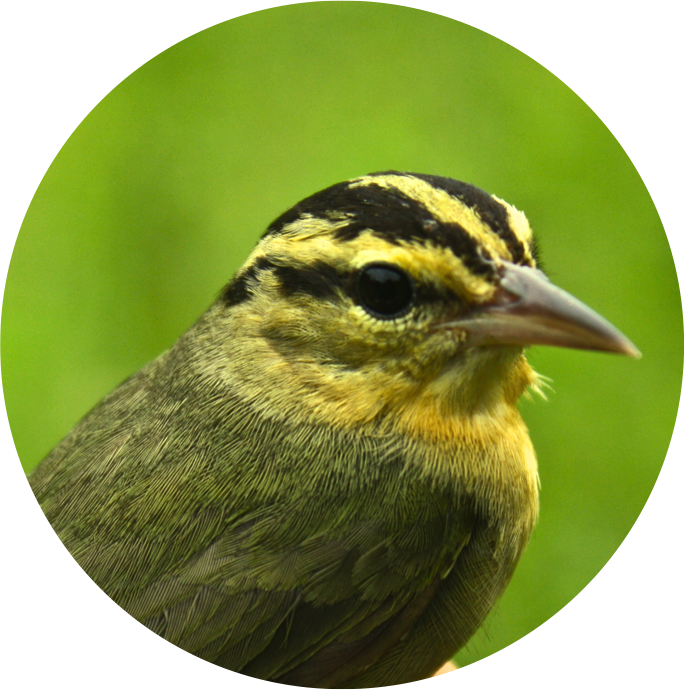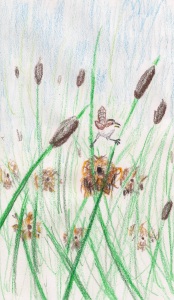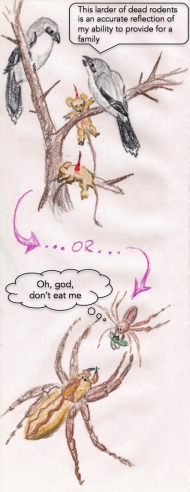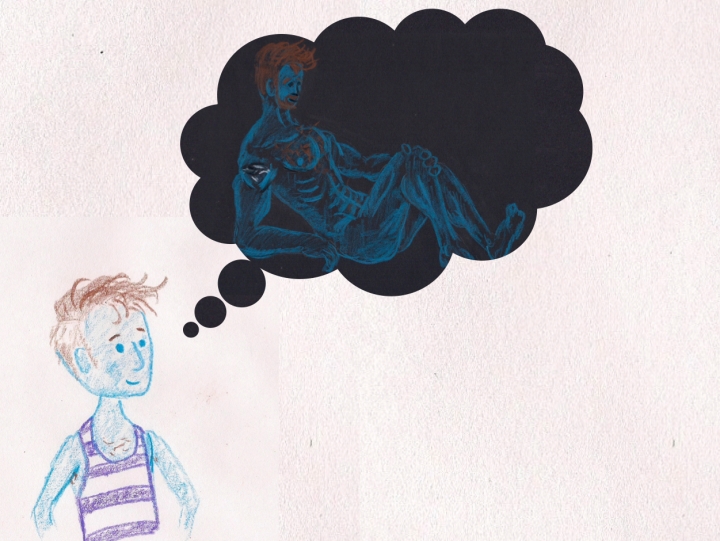Charles Darwin got there first.
Yes, Alfred Russell Wallace was hot on his heels. Yes, Erasmus Darwin had offered a comparable hypothesis (albeit lacking mechanism). Yes, Lynn Margulis championed theories that added lightyears of insight to the story of life…but Charles Darwin got there first.
All us evolutionary wannabes are scrambling to catch up. Every word I’ve written and logical chain I’ve argued in this trilo-blog follows a well-trodden groove that began with The Origin of Species and The Descent of Man, a groove worn smooth by the likes of Julian Huxley, Ronald Fisher, Ernst Mayr, E.O. Wilson, and many others. All that neurotic chatter about muscle mass, male contests, and fancy adornment? It inevitably leads here.
With that in mind, I’ll let Chucky D open this final chapter for me:

The Descent of Man, Chapter 8 [1]. Emphasis and pigeons added by me.
Much like adornments, some displays can be practical. If you have ever owned a male Betta fish (Betta splendens), you probably observed it blowing masses of bubbles. Those frothy structures are nests for eggs, and are an important criteria for females searching for a mate [2].
Nest building is a common courtship component in fish and bird species, and it can get a little out of hand. I once foolishly attempted to monitor a pair of House Wrens (Troglodytes aedon) breeding in my yard, only to discover that the male was building bags of nests, and the female only laid in the ones I didn’t find. This is a trope in the wren family (Troglodytidae). Male Marsh Wrens (Cistothorus palustris) will build as many as 12 nests, only a few of which will receive any use by females. There has been some debate as to whether this overzealous home-building is an advertisement of male quality [3], a function of polygyny [4], or just a way to screw with predators/ornithologists [5]. Whatever the explanation, the building of at least one nest is a signal of a male’s capacity as a parent.
Another example of practical courtship is nuptial feeding. In many insect [6], arachnid [7], and bird species [8], males will woo females with a romantic meals. Male shrikes (Laniidae, one of the gnarliest passerine families out there) maintain “larders” of impaled mice and lizards. Female shrikes prefer males with the most macabre displays, and lay more eggs when males bring the bloody mess right to them [9].
Likewise, males of some insect species deliver salts and other sustenance to aid females in egg production. These nuptial gifts can be captured prey, but often take the form of a spermatophore–a nutritional matrix filled with ejaculate that females eat after absorbing the sperm [10]. It’s like a gift with edible wrapping paper, only much grosser.
In arachnids, the role of nuptial feedings is more complicated. While a prey offering may help enrich the eggs the female lays, it’s also conceivable that the male is hoping to just sate the female enough to live and mate another day [11].
The parallels between nest building/nuptial feeding and human behavior are easy to draw. A whole slew of studies have addressed the relationship between male wealth and reproductive success. The selection gradient diminishes somewhat with industrialization [12], but on the whole the wealthiest blokes take the lion’s share of mating opportunities [13, 14, 15]. Alas, my paltry checking account and moldering 403(b) are unlikely to win me any suitors.
Fortunately, many displays don’t require material goods to be found attractive. You could trawl the internet for weeks without running out of videos of exaggerated animal courtship performances (for real). Some displays are simple, like the push-up performance by Sceloporus lizards that show off male’s upper body strength and flashy sides:
So strong. So manly.
Other displays are more complicated, like the tremendous dancing of peacock spiders (Maratus sp.), who have risen to internet fame thanks to Jurgen Otto high-resolution videography.
Other displays seem to be just plain annoying. Male red-eared sliders (Trachemys scripta) will use their long finger claws to repeatedly tap and brush females’ faces. It’s as weird as it sounds. If someone did that to me for 20 minutes, I’d probably mate with them just to get them to lay off.
Shtaaaaaaaaaahp
With such a preponderance of courtship displays, we have to ask: are they a signal of male quality, or merely an invitation to mate? After all, complex displays can function to prevent inter-species mating, allowing both sexes to avoid issues of gametic incompatibility [16, 17]. To ensure that courtship is a sexually selected signal of quality and not just a pre-zygotic barrier to hybridization, we need to determine whether variation in display within species reflects male quality, and in turn translates into female preference.
For our starting example, let’s look at a species familiar to us North Americans: the Song Sparrow (Melospiza melodia). This streaky little creature breeds cross the northern US and Southern Canada, and down California into Baja (range map here).
If you spend time this spring in open fields, you’ll notice that individual sparrows have uniquely variable songs; some males sing several complex songs, while others seem stuck with a few dull melodies.
Zounds! A variable display! So does variation reflect female preference?
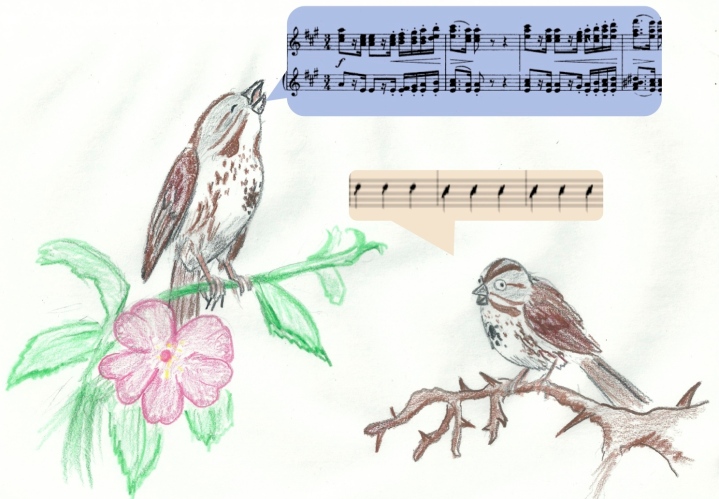 Indeed, captive female Song Sparrows solicit copulations more frequently when exposed to more diverse repertoires of recorded songs in lab settings [18]. Additionally, more diverse song repertoires are predictive of higher reproductive success in wild male Song Sparrows [19], suggesting that repertoire diversity is an honest signal of male quality.
Indeed, captive female Song Sparrows solicit copulations more frequently when exposed to more diverse repertoires of recorded songs in lab settings [18]. Additionally, more diverse song repertoires are predictive of higher reproductive success in wild male Song Sparrows [19], suggesting that repertoire diversity is an honest signal of male quality.
The relationship between male song quality and female preference is well established in many songbird species [20, 21, 22] and some insects [23, 24]. But what makes song an honest signal of male quality? Much like fluctuating asymmetry, song may reflect a bird’s past. A low-quality bird that couldn’t obtain the calories to grow the neural circuitry, and thus have a smaller song repertoire [25].
The costs of courtship don’t stop at learning displays. Often, the display itself is injurious to the performing. Take wolf spiders: males court females by sending vibrations through the substrate and waving about their heavily tufted forelegs. Female wolf spiders show preference for larger tufts and better vibrations, as demonstrated by simulated males in the Uetz lab in the video below. When researchers induced increased drumming frequency by presenting males with a line-up of females, males rapidly lost weight…and sometimes just plain died of exhaustion [26].
Other examples of display-hard/die-young can be here and here, but perhaps my absolute favorite cost-of-display example is with the Cock-of-the-Rock (Rupicola sp).

An Andean Cock-of-the-Rock (Rupicola peruvianus). Photo by Joel Lisenby, shared under CC BY-SA 3.0 via Wikimedia
There are two species (give or take) of these South American cotingas: Guianan and Andean. The males are bizarre creatures, searing red or orange with crests that cover their beaks and alien-bright irises; the females are a subdued rust-brown. The species is highly dimorphic in its behavior as well; females raise offspring entirely on their own, and only interact with males when mate-searching. When females are searching, males certainly put on a show.
Cock-of-the-Rocks (or Cocks-of-the-Rock? Cocks-of-the-Rocks?…let’s call ’em COTRs) engage in lek mating: males gather in geographically fixed locations to compete and display for soliciting females. Freed from the demands of parenting, males spend their days preening, strutting, and make a ruckus whenever a single lady shows up.* I really mean ruckus–this is what a lek sounds like when a female kicks it into high gear:
Now, imagine you are a predator wandering the rainforest understory. It’s dark and quiet; most prey items are small and quick, cautiously flitting through shadows. Suddenly, you come upon a lek of screaming, blaze-bright birds entirely focused on showing off.
Turns out this a real consequence for COTR leks. A paper by Pepper W. Trail in 1987 [27] described how frequently male leks would flip out over incoming predators…or flip out because of false alarms. 90% of the times the males fled crashing into the vegetation, it was for false alarms.
As if waiting around to holler for a quickie while predators snatch at you from the shadows, mating success in lek species is incredibly skewed: usually one or a few males win most of the paternity in a given breeding season. Seriously, can you image participating in this silly dance for months on end and never getting laid?
Blue Manakin (Chiroxiphia caudata) Lek. Only one guy is gonna be invited to partake in some nookie.
Birds aren’t the only group whose antics draw in the hungry nasties [28, 29]. Male túngara frogs (Physalaemus pustulosus) risk getting snatched by fringed-lipped bats (Trachops cirrhosis) each time they join the chorus [sick imagery of that here and here]. To make matters worse, the complicated calls that females túngara frogs prefer are also preferred by bats.; the better a male sings for ladies, the easier it is for bats to find him [30].
Darwin and most of his successors have seen parallels between the song and dance of the animal kingdom and those of our own species. There are legitimate arguments that our artistic traditions are as much about social bonding as they are about mate selection, and I suspect there’s a lot of truth to that hypothesis [31]. However, the sexually dimorphic registers of human voices [32], females’ increased preference for lower pitches when fertile [33], and the seemingly supernatural allure of guitarists suggest that musical and dancing facility may be yet another signal used in human mate selection.
Also, remember that discussion of fluctuating asymmetry in Part 1? It turns out that there’s a strong relationship between a man’s symmetry and his dancing abilities: more symmetrical dudes have better moves than us Lopsided Larry’s [34]. Moreover, dancing highlights existing asymmetries, such that the attractive power of a man’s shimmy diminishes with increasing physical asymmetry.
If you’ve stuck with me to this point, you know what’s coming next: this is the part where I point out how the cited research indicates my paucity of attractive quality.
Truth be told, I’m not horrible with music; I can carry a tune if need be. But I am an abysmal dancer…think along the lines of Allie Brosh‘s experiences recreating Beyoncé. I spend most of my time in clubs awkwardly shuffling by my lonesome while my boyfriend and friends cut every rug in the joint.
So what’s the point of all this? I’ve burned some 6,000 words highlighting all the ways I cannot be considered attractive from a biological or sexual selection-perspective. Can I say anything to redeem this self-pity party? Isn’t there supposed to be some moral that me and all the fugly uggos can use to lift our spirits?
Of course there is. Next time you’re sitting around, anxious about whether you’re hot enough to make par, or glowering at everyone fitter than you at the gym, take a moment to imagine yourself as you’d like to be. Really indulge yourself. Picture your body, its every angle and curve ideal. Visualize your shape as buxom or lanky, gracile or virile, your every blemish erased–whatever your fantasy is, hold it fully in your mind and really see it.
Now, without forgetting what that person looked like, summon an image of the people you admire most. Picture all those people–living or dead–you think really matter, people whose approval you strive to obtain, people who you could point to and declare: “This person, they are worthy of emulation!”
If you’re even a half-developed human, you didn’t choose your heroes on the basis of sex appeal. Some might as homely as the rest of us mere mortals.
If your idols are handsome, I bet that quality pales in comparison to their other distinctions: brilliance, devotion, compassion, diligence, equanimity, patience, and a hundred other noble elements that contribute to greatness.
Don’t sully these concepts by claiming morality is hot, or that altruism is lush. I know you want to, but don’t. Kindness, perseverance, courage, forgiveness, honesty don’t need to be sexy. They are traits with intrinsic merit.
I guess the moral of the story is this…whether you think of attraction is selected for, or culturally determined, or in the eye of the beholder, the hard truth remains the same: we may never be as attractive as we want to be–no matter what a Dove Commercial says.
All we can do is try our best to not give a fuck because there are much higher aspirations than physical perfection. The unrelenting pursuit of justice, determination to unveil the mysteries of the universe, commitment to serving the least of our brothers–such attributes are the making of true champions.

Dr. Jonas E. Salk, creator of the polio vaccine. Rather than get rich with this creation, Dr. Salk did not patent the vaccine. The lowered cost of production ensured has saved millions of lives. Public Domain Image.
Among my resolutions for this year is demote being attractive to the lowest of my ambitions. If I could reach into my past to exchange every second of body anxiety for a moment that I took to be kind, or to enrich my mind, or to be creative…heavens, my life would look different today.
So here’s to making life look different. Here’s to tossing aside body dysmorphia and leaving the mad game of sexual selection to creatures who can’t aspire to higher ideals, creatures who have no need of justice or virtue or science.
Besides, they look better displaying than any of us.
Footnote
*If you ever have a chance to visit any kind of lek, I highly recommend it; they are among the most hilarious and transfixing phenomenon in nature. If you’re a North American, you can probably check out a Prairie Chicken lek. However, please be careful and respectful to the lek when you do visit–flushing the displaying males could be energetically costly and lower the quality of the lek site.
**This illustration is a little misleading. The advantage of having a noisier, more vigilant lek are discussed in Pepper paper. But I really wanted to draw a derpy COTR being attacked by a snake, so I did.
Citations
1. C Darwin. 1871. The descent of man, and selection in relation to sex.
2. ED Clotfelter, LJ Curren, and CE Murphy. 2006. Mate choice and spawning size, display behavior, and nest size. Ethology 112(12): 1170-1178.
3. KJ Metz. 1991. The enigma of multiple nest building by male marsh wrens. The Auk 108: 170-173.
4. J Verner and GH Engelsen. 1970. Territories, mutliple nest building, and polygyny in the long-billed marsh wren. The Auk 87(3): 557-567.
5. ML Leonard and J Picman. 1987. The adaptive significance of multiple nest building by male marsh wrens. Animal Behaviour 35(1): 271-277.
6. K Vahed. 1998. The function of nuptial feeding in insects: a review of empirical studies. Biological Review 73(1): 43-78.
7. K Vahed. 2007. All that glistens is not gold: sensory bias, sexual conflict and nuptial feeding in insects and spiders. Ethology 113(2): 105-127.
8. D Lack. 1940. Courtship feeding in birds. The Auk 57(2): 169-178.
9. A Carlson. 1989. Courtship feeding and clutch size in Red-backed Shrikes (Lanius collurio). The American Naturalist 133(3): 454-457.
10. DT Gwynne. 1984. Courtship feeding increases female reproductive success in bushcrickets. Nature 307: 361-363.
11. P Stålhandske. 2001. Nuptial gift in the spider Pisaura mirabilis maintained by sexual selection. 12(6): 691-697.
12. D Nettle and TV Pollet. 2008. Natural selection on male wealth in humans. The American Naturalist 172(5): 658-666.
13. B Pwalwski and RIM Dunbar. 1999. Impact of market value on human mate choice decisions. 266: 281-285.
14. RL Hopcroft. 2006. Sex status, and reproductive success in the contemporary United States. Evolution and Human Behavior
15. T Bereczkei, S Voros, A Gal, and L Bernath. 1996. Resources, attractiveness, family commitment; reproductive decisions in human mate choice. Ethology 103(8): 681-699.
16. WC Davis and VC Twitty. 1964. Courtship behavior and reproductive isolation in the species of Taricha (Amphibia, Caudata). Copeia 4: 601-610.
17. JD Hollander, H Dijkstra, H alleman, L Vlijm. 1973. Courtship behavior as species barrier in Pardosa pullata group (Araneae, Lycosidae). Journal of Arachnology 7: 121-128.
18. WA Searcy, PD McArthur, and K Yasukawa. 1985. Song repertoire size and male quality in Song Sparrows. The Condor 87: 222-228.
19. JM Reid, P Arcese, ALEV Cassidy, SM Hiebert, JNM Smith, PK Stoddard, AB Marr, and LF Keller. 2011. Song repertoire size predicts initial mating success in male song sparrows, Melospiza melodia. Animal Behaviour 68(5): 1055-1063.
20. TI Drăgănoiu, L Nagle, and M Kreutzer. 2002. Directional female preference for an exaggerated male trait in canary (Serinusanaria) song. ProcB 269: 2525-2531.
21. TQ Getner and SH Hulse. 2000. Female European Starling preference and choice for variation in conspecific male song. Animal Behavior 59(2): 443-458.
22. K Yasukawa, JL Blank, and CB Patterson. 1980. Song repertoires and sexual selection in the Red-winged Blackbird. Behavioral Ecology and Sociobiology 7(3): 233-238.
23. MG Ritchie, RM Townhill, and A Hoikkala. 1998. Female preference for fly song: playback experiments confirm the targets of sexual selection. Animal Behaviour 56(3): 713-717.
24. LW Simmons. 1987. The calling song of the field cricket, Gryllus bimaculatus (de geer): constraints on transmission and its role in inter male competition and female choice. Animal Behaviour 36(2): 38-394.
25. S Nowicki, W Searcy, and S. Peters. 2002. Brain development, song learning, and mate choice in birds: a review and experimental test of the “nutritional stress hypothesis”. Journal of Comparative Physiology A 188(11-12): 1003-1014.
26. J Mappes, RV Alatalo, J Kotiaho, and S Parri. 1996. Viability costs of condition-dependent sexual male display in a drumming wolf spider. ProcB
27. PW Trail. 1987. Predation and anti predator behavior at Guianan Cock-of-the-Rock leks. The Auk 104(3): 496-507.
28. C Magnhagen. 1991. Predation risk as a cost reproduction. TREE 6(6): 183-186.
29. T Ulmar Grafe. 1997. Costs and benefits of mate choice in the lek-breeding reed frog, Hyperolius marmoratus. Animal Behaviour 53(5): 1103-1117.
30. XE Bernal, AS Rand, and MJ Ryan. 2007. Sexual differences in the behavioral response of túngara frogs, Physalaemus pustulosus, to cues associated with increased predation risk. Ethology 113(8): 755-763.
31. EH Hagen and GA Bryant. 2003. Music and dance as a coalition signaling system. Human Nature 14(1): 21-51.
32. S Evans, N Neave, and D Wakelin. 2006. Relationships between vocal characteristics and body size and shape in human males: An evolution explanation for a deep male voice. Biological Psychology 72(2): 160-163.
33. DA Puts. 2005. Mating context and menstrual phase affect women’s preference for male voice pitch. Evolution and Human Behavior 26(5): 388-397.
34. WM Vrown, L Cronk, K Grochow, A Jacobson, CK Liu, Z Popovic, and R Trivers. 2005. Dance reveals symmetry especially in young men. Nature 438: 1148-1150.
